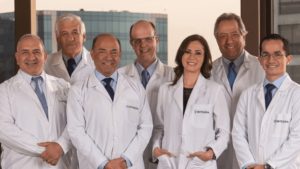Follow Your Heart
Aortic Valve Replacement in Guatemala City
Sit quietly, breathe deeply, meditate inward, and appreciate the rhythm of your heartbeat. The thumping sound you hear is the mitral and aortic valves of your heart opening and closing to allow your blood to flow like a river of healing energy. Every day, the heart pumps about 2,000 gallons, or 7,500 liters, of blood through these chambers, then throughout 60,000 miles of blood vessels. The heart beats about 100,000 times per day to supply all 75 trillion cells in the body with freshly oxygenated blood.
Four heart chambers work in unison: two atria, or “entrance halls” in Latin, and two ventricles, meaning “little belly” or “Panza chica”, below them. The heart’s contractions force blood through the three leaflets of the aortic valve to the body’s primary artery, the aorta. More importantly, the leaflets snap shut to block a leakage of blood back into the left ventricle.
Delicate valves can suffer from stenosis, becoming blocked by calcification or hardening, so that they constrict the blood flow. Others become floppy and inefficient, allowing for regurgitation, typically known as a “leaky heart valve”.Replacement aortic heart valves could be mechanical, made from durable substances that can exist within the body without infection. Bioprosthetics are biological valve replacements, made from tissue from the patient or a donor.
Our day starts early at UNICAR Cardiac Surgery Hospital in Guatemala City. By 7:00 am, today’s patient is calm and prepared, ready to undergo open heart surgery, an aortic valve replacement.
The operating room, or “theatre” to our British friends, is exactly that. As with any major production, a crucial part of a live performance happens behind the scenes. Skilled and devoted technicians prepare every tiny detail of the setting, to assure an absolutely flawless performance.
Wardrobe has selected a sea of blue surgical garments from head to toe, the only exception being the frame of the patient’s chest, at center stage. Lighting design includes huge disks, with specialized O.R. bulbs, which drop from the ceiling to illuminate the scene, because we wouldn’t want to miss a thing.
Entering stage left, the surgical staff interacts seamlessly, with respect and affection, like a tight-knit cast who have been rehearsing their lines together for many years. The doctors’ playlist choice for today’s procedure is Brazilian jazz, Spanish guitars, and “Imagine” by John Lennon.
In the opening scene, Dra. Carolina Gallardo administers the anesthesia, and Dr. Morales, the cardiovascular perfusionist, prepares the cardiopulmonary bypass machine to take over the patient’s circulation during the operation. For more than an hour, cardiac surgeon Dra. Sandra Dominguez and her assistant prepare the chest cavity and open the pericardium.
Enter our star and director, cardiothoracic surgeon, Dr. Rodolfo Bonilla, with over 30 years of experience performing thousands of cardiac procedures, from angioplasties to CABG, or coronary artery bypass grafts. In this role, the script requires Dr. Bonilla to stop the heart from beating, redirect the blood to the heart-lung machine, remove and replace the faulty heart valve, and then resume blood flow and normal heart rhythm.
Every sixty seconds, five liters of blood flow over valves that open and close 70 to 80 times, but the doctors and their assistants need to work on a calm heart, with neither fluids nor motion. They must divert the blood to adesk-sized heart-lung machine filled with oxygenators, filters, gauges, pumps, reservoirs, tubes, plugs and clamps. It’s astounding to contemplate the miraculous efficiency and reliability of our little 11-oz heart, squeezing and sucking, opening and closing, doing exactly the same thing for 24 hours every day of our lives.
Four hours later, the delicate surgery is a brilliant success, worthy of the highest critical acclaim. But we hear neither applause nor ovation. Dr. Bonilla and his cardiac surgery team will repeat this procedure tomorrow, and the next day too, just as they have done together for years.
This real-life drama does not end with a curtain closing, but with a following act, the ability to appreciate every day that our hearts continue to be active, healthy and rhythmic.
Imagine.
It’s important to note that some people experience no symptoms, not even a tiny heart murmur, and still live with the threat of severe aortic valve disease. Without timely surgical intervention, a patient could experience major complications, like an enlarged heart muscle, potentially leading to congestive heart failure.
If your doctor recommends a heart valve replacement, be sure to investigate the level of insurance coverage you can depend on, because without financial assistance, prices for open heart surgery can exceed $200,000 in the United States. In Guatemala, you can depend on medical providers with the same surgical skills and technology as many other private hospitals worldwide. This superior medical attention, including VIP personal care with your medical advocate, will likely cost you less than $26,000.
Breathe deeply, consider carefully, and follow your heart.
Fun facts about your heart…
- Every day, the heart creates enough energy to drive a truck 20 miles. In a lifetime, that is equivalent to driving to the moon and back.
- When the body is at rest, it takes only six seconds for the blood to go from the heart to the lungs and back, only eight seconds for it to go the brain and back, and only 16 seconds for it to reach the toes and travel all the way back to the heart.
- A kitchen faucet would need to be turned on all the way for at least 45 years to equal the amount of blood pumped by the heart in an average lifetime.
- Five percent of blood supplies the heart, 15-20% goes to the brain and central nervous system, and 22% goes to the kidneys.
- In 1929, German surgeon Werner Forssmann (1904-1979) examined the inside of his own heart by threading a catheter into his arm vein and pushing it 20 inches and into his heart, inventing cardiac catheterization, which is now a common procedure.
By Lori Shea


